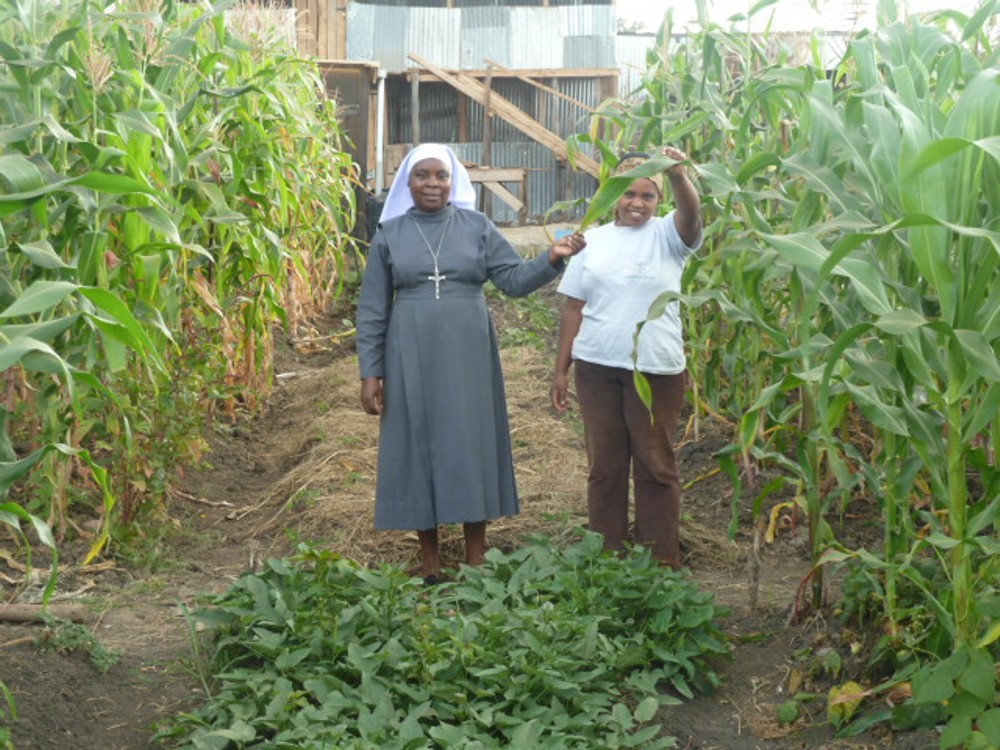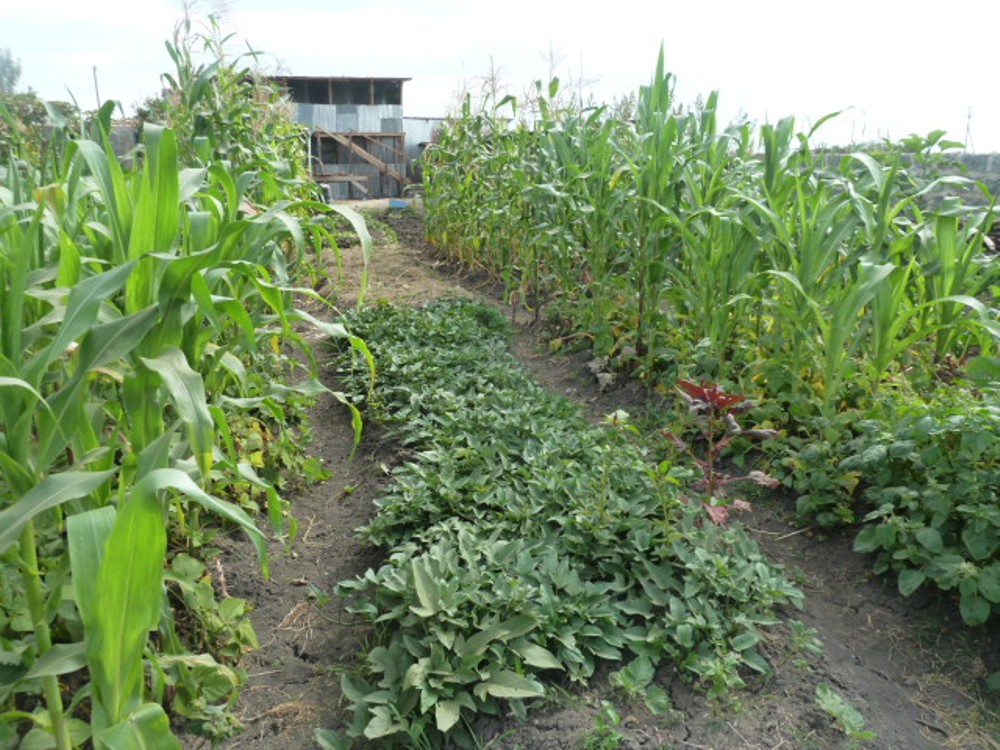A GROW BIOINTENSIVE
Soil Research Project in Kenya
by Samuel Nderitu and John Beeby
 Many agricultural soils around the world, particularly those used in smaller-scale agriculture, are low in critical nutrients, which reduces the yields, nutritional content, and resistance to pests and droughts of the crops produced. Soil tests and almost any type of fertilizer are either unavailable or not affordable for many of the farmers who work these soils. The goal of the project (described below) is to determine if soils can be improved with limited inputs of fertilizers and careful soil management, using the GROW BIOINTENSIVE® method. Many agricultural soils around the world, particularly those used in smaller-scale agriculture, are low in critical nutrients, which reduces the yields, nutritional content, and resistance to pests and droughts of the crops produced. Soil tests and almost any type of fertilizer are either unavailable or not affordable for many of the farmers who work these soils. The goal of the project (described below) is to determine if soils can be improved with limited inputs of fertilizers and careful soil management, using the GROW BIOINTENSIVE® method.
Samuel Nderitu, the director of the GROW BIOINTENSIVE Agriculture Centre of Kenya (G-BIACK), received a one-year grant from the REAP Fund to determine if farmers can add a single, affordable application of organic fertilizers in one year and then carefully manage their soils to retain those nutrients and increase the fertility of the soil over the next three years. G-BIACK and three farmer-collaborator sites have begun this study this year and will continue to test soils and measure yields over three years to determine if they are successful at improving their soils' fertility. Samuel selected these three farmers, not only for their interest in the project and their experience with GROW BIOINTENSIVE, but also because of their locations and connections with many other farmers throughout Kenya. Through field days and open days for farmers in the communities where this experiment is being conducted, G-BIACK expects to benefit 6,000 farmers with the knowledge gained from this experiment.
In this first year, the soils of each site have been sampled and tested. Soil samples were collected in each of the four farms and taken to Crop Nutrition Laboratory Services (www.cropnuts.com) in Nairobi for soil testing. This is an outstanding lab that is ISO 17025-accredited (unlike many US labs) and produces high-quality analytical results at a reasonable price. In addition, this laboratory provided a general fertilizer recommendation for each of the four submitted samples. Fertilizer recommendations were also provided by Timberleaf Soil Testing (www.timberleafsoiltesting.com). John Beeby, who designed this experiment and consults with Samuel Nderitu throughout this project, took both fertilizer recommendations, determined what organic fertilizers were actually available to Samuel for purchase, and then created an optimal organic fertilizer application recommendation for each site.
Samuel then purchased all necessary organic fertilizers and distributed them to each farm, training the farmers involved on the most effective way of applying each fertilizer based on the dynamics of the nutrients they contain. Each farmer applied the fertilizers they needed, which were some or all of the following at application rates specific to each soil: Minjingu rock phosphate, composted cow manure, and agricultural lime. The intention of this project is that no additional fertilizers will be added, but that fertility will be increased by focusing on using at least 70% of each farmer's beds to produce crops that generate high amounts of residues to be composted and added back to the soil to improve soil organic matter content. In addition, each farmer will make efforts to reduce the amount of nutrients that are removed from the soil, not only through increasing soil organic matter, but also by minimizing erosion, recycling as much of the crop biomass as possible back to the soil as mulch or compost, and limiting the amounts of crops that are sold.
On April 19, 2012, after the fertilizers were applied on each of the ten beds (10 square meters each) of each of the four farms, these beds were planted with the same crops across the farms: three beds of maize (corn) (a great producer of both compost material and calories), one bed of amaranth (the leaves are highly nutritious), two beds of sorghum (another great producer of both compost material and calories), one bed of sweet potatoes (excellent for producing a lot of calories per unit of area), two beds of cowpeas, and one bed of lablab (an outstanding nitrogen-fixer; unlike most beans, lablab can produce enough nitrogen for its seeds and still contribute some nitrogen to the soil). Planting occurred near the beginning of the rainy season. Germination has been very good across all of the crops and farms. However, two farms, G-BIACK and Athi Gravity, were affected by floods caused by heavy rains in May, and some beds needed to be replanted. G-BIACK replanted four beds while Athi Gravity replanted five beds. The replanted beds have all germinated very well, and to date all of the crops are doing well.
Since many small farmers do not have scales to weigh their yields, yields will be measured using a common 2-kg container that is normally used by many farmers in Kenya. The estimated production of these crops on these farms prior to this experiment has been as follows (on a per-bed basis): maize, 1 kg; sorghum, 0.5 kg; amaranth, 2 kg of vegetable leaves; cowpeas, 1.5 kg of vegetable leaves; lablab, 1.75 kg of seeds; sweet potatoes, 10 kg. We will use these yields as our baselines and will hope to see continual increases throughout the course of the next three years. Of course, climate and rainfall are significant variables for which we cannot control, as these farms are not irrigated but rain-fed.
This three-year project requires a lot of discipline and commitment from all the farmers involved because the GROW BIOINTENSIVE technique has to be used strictly in order to properly test our hypothesis and achieve our goals. All of the farmers involved are experienced with GROW BIOINTENSIVE and are committed to using these techniques to achieve the goals of this project. We are blessed to have such a committed team to support this novel and potentially important experiment.
If the first year is successful, we intend to apply for additional financial support in order to include more farmers in subsequent years. We will share all of our findings with nearby communities so that other farmers can benefit by this study, and we will create an annual report describing our findings that will be available to the public on the G-BIACK website. It is our hope that this experiment will lead to a better understanding of how to increase soil fertility with only a small, affordable, one-time application of organic fertilizers and careful, sustainable soil management, two things that practically any farmer in the world can do.
top | Newsletter Home | Article Index

|


 Many agricultural soils around the world, particularly those used in smaller-scale agriculture, are low in critical nutrients, which reduces the yields, nutritional content, and resistance to pests and droughts of the crops produced. Soil tests and almost any type of fertilizer are either unavailable or not affordable for many of the farmers who work these soils. The goal of the project (described below) is to determine if soils can be improved with limited inputs of fertilizers and careful soil management, using the GROW BIOINTENSIVE® method.
Many agricultural soils around the world, particularly those used in smaller-scale agriculture, are low in critical nutrients, which reduces the yields, nutritional content, and resistance to pests and droughts of the crops produced. Soil tests and almost any type of fertilizer are either unavailable or not affordable for many of the farmers who work these soils. The goal of the project (described below) is to determine if soils can be improved with limited inputs of fertilizers and careful soil management, using the GROW BIOINTENSIVE® method.
